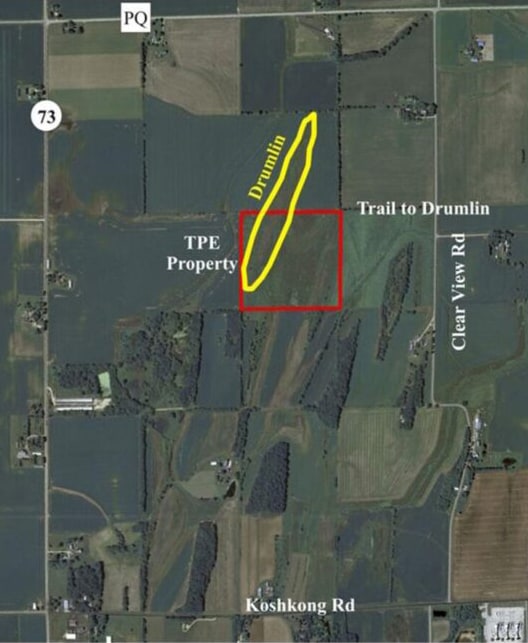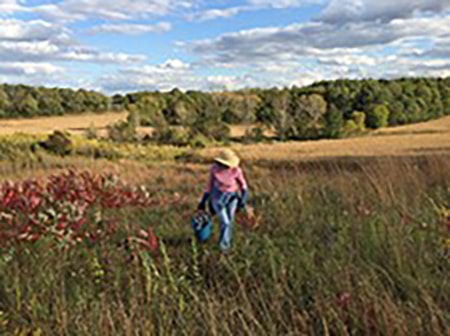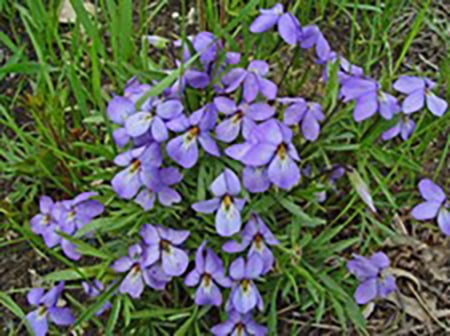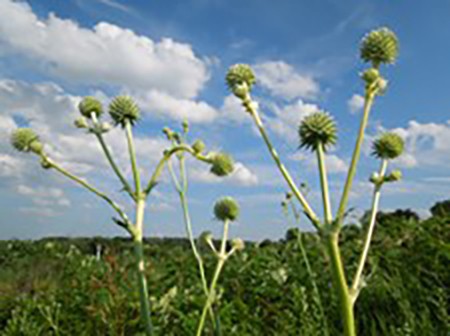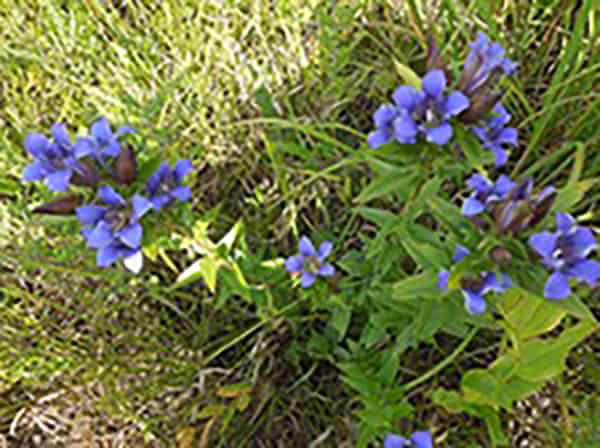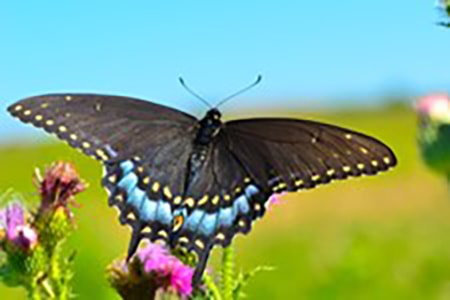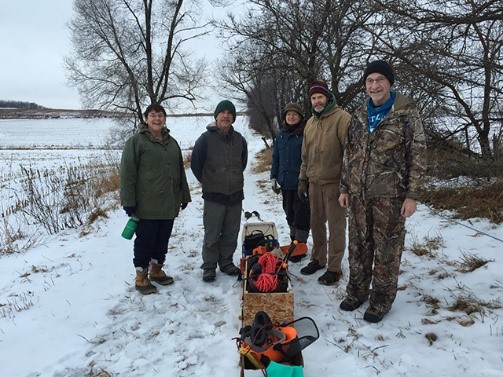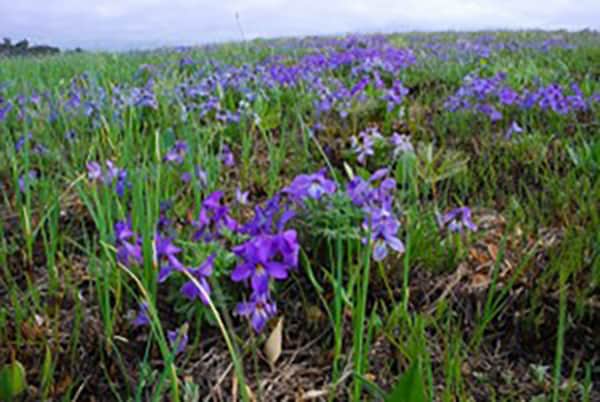
Smith-Reiner Drumlin Prairies
Come experience this special 40-acre preserve located in eastern Dane County, WI. Smith-Reiner Drumlin Prairies was acquired in 2011 by The Prairie Enthusiasts and is managed by the Empire-Sauk Chapter as a Wisconsin State Natural Area. It encompasses two dry upland remnants of original prairie on drumlin hills with massive displays in August of cylindrical and rough blazing stars.
The site harbors over 100 native prairie species including stunning displays of early spring wildflowers and a healthy population of the federally-threatened prairie bush-clover. Since the preserve is all in grassland cover, many grassland birds use it for nesting, including eastern meadowlark, field sparrow, dickcissel, grasshopper sparrow and (outside of breeding season) short-eared owl.
ACCESS & DIRECTIONS
From the intersection of Highway 12/18 and Highway 73 (two miles west of Cambridge, WI) go south on Highway 73 for 1.5 miles, then east on County Highway PQ for 1 mile, then south on Clearview Road for 0.5 mile. Park in the small parking lot off of Clearview Road and walk west .25 miles on an old farm lane into the natural area.
Google Map
Description & Significance
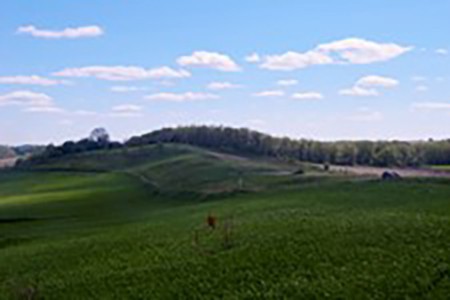
The Prairie Enthusiasts and Wisconsin Department of Natural Resources have ranked Smith-Reiner Drumlin Prairies as a top-tier prairie remnant. The term drumlin is from an Irish word meaning “little hill.” Drumlins are long, narrow whale-shaped hills that were formed by glaciers. The last glacier to move across southeast Wisconsin did so in a northeast to southwest direction, thus the setting orientation of the hills.
Drumlins are composed of the till (rock, gavel, and sand) pushed along and ground up under the ice. Today, the preserve’s hills are still covered with their original sod of prairie plants (13 acres) which have been in place for at least 4-5 thousand years. The remnants are imbedded within productive cropland (28 acres) which have been enrolled in the USDA Conservation Reserve Program (CRP) since 1988. Originally, planted to smooth brome grass, TPE is now converting these fields to prairie vegetation with the first seeding done in the fall of 2013.
Prairie dropseed is a type of now uncommon prairie grass that is important to many prairie species of leafhoppers, including Memnonia panzeri, a State Special Concern species that feeds exclusively on this plant. Both the grass and the rare leafhopper are present on this preserve.
A few pockets of deeper soil on the drumlins support species such as this prairie lily (Lilium philadelphicum) compass plant and rattlesnake master that are more typical of mesic (deep soil) prairies. Prairie lily plants will grow on both acid and high pH soils and grow best in dry-mesic to mesic habitat. It takes seven to eight years before a prairie lily plant growing in the wild will get big enough to bloom.
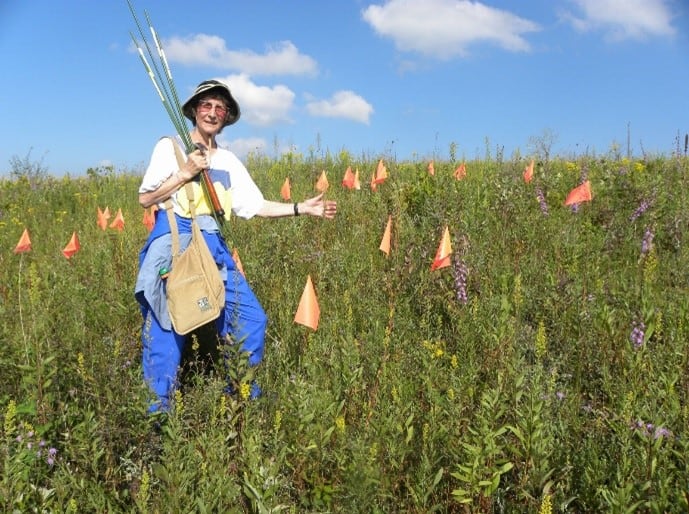
In 2003, Shirley Ellis, local conservationist, discovered five plants of the federally-threatened prairie bush clover,Lespedeza leptostachya. By 2010, after brush clearing and prescribed burns by TPE volunteers, the prairie bush clover population had increased to 113 plants. The U.S. Fish and Wildlife Service provided funding to help acquire the site because of the presences of this threatened species. It is restricted to original prairie sod, and is known only from four states: Iowa, Illinois, Minnesota and Wisconsin. Loss of habitat is the main reason for its rarity.
In 2005, another rare plant, pale purple coneflower (Echinacea pallida, threatened in WI) was introduced to the site using seed from a native population near Cross Plains, WI in western Dane County.
Phyllis Reiner Smith, whose family were previous owners of the land, remembered looking for spring wildflowers on the drumlin hills as a child (ca. 1929-1935), especially the pasque flowers which are present at Smith-Reiner Drumlin Prairie.
Natural History
The site contains two linear, parallel, drumlin hills formed by the passing of the last glacier more than 11,000 years ago. Such glacially sculpted ridges or drumlins are a common feature between Madison and Milwaukee, and they once were covered with prairie and savanna. Southern Wisconsin is world famous for its rare drumlins. In the 1840s, Smith-Reiner Drumlin Prairie was part of a 7,000-acre treeless prairie that had been in place for 4-5 thousand years.
When European settlers first came to this area, they found a vast sea of grasses and wildflowers that were part of a continuous tallgrass prairie ecosystem stretching west to the Great Plains. These prairies had many species of grasses such as big and little bluestem and Indian grass that grew to heights of five to six feet, limited tree cover, and hundreds of species of wildflowers. Frequent fires that occurred either naturally, through lightning strikes, or through the actions of Native Americans, limited the encroachment of most trees and shrubs. Some trees such as bur oaks could survive frequent fires due to their fire-resistant bark, but only in low numbers. Fires also stimulated growth of prairie grasses and wildflowers. The deep roots of prairie plants develop rich, fertile soils that were eventually prized by European settlers for agricultural use. When the invention of the mould board plow allowed the native prairie sod to be busted and converted to crop fields, over 99% of original tallgrass prairie was lost. As a result, many species that relied upon prairies are now rare. Of the prairie and grassland species found in Wisconsin, 41 are listed as endangered or threatened.
Geography, Topography & Soil Types
The drumlins are composed of glacial till (subglacial rock soil debris) including deposits of sand and gravel, making for a blend of dry, dry-mesic, and even a few pockets of mesic prairie of varying soil pH. The east drumlin has a sandier soil with a lower pH level (acidic) and the west drumlin soil contains dolomitic limestone bedrock slopes with a higher pH level (alkaline). Agriculture was unsuited to grow croplands on drumlins due to their gravelly consistency. The preserve’s prairie remnants were grazed until sometime in the early 1950’s, thus they are not pristine. The berms evident along the base of the hills were constructed in the 1960s, as part of a federal soil conservation practice that has since fallen out of use. Today, the driest portions of the preserve are now once again high quality prairie, and more mesic areas are recovering nicely with a good population of native species.
Plant Communities
Early season blooming forbs:
- bird’s foot violet (Viola pedata)
- prairie violet (Viola pedatifida)
- blue-eyed grass
- hoary puccoon (Lithospermum canescens)
- prairie smoke (Geum triflorum)
- spiderwort
Mid-summer blooming forbs:
- black-eyed Susan (Rudbeckia hirta)
- common milkweed (Asclepias syriaca)
- whorled milkweed (Asclepias verticillata)
- compass plant (Silphium laciniatum)
- flowering spurge (Euphorbia corollata)
- lead plant (Amorpha canescens)
- pale purple coneflower (Echinacea pallida)
- prairie coreopsis (Coreopsis palmata)
- prairie dock (Silphium terebinthinaceum)
- prairie lily (Lilium philadelphicum)
- purple prairie clover (Dalea purpurea)
- rattlesnake master (Eryngium yuccifolium)
- wild rose
- yellow coneflower (Ratibida pinnata)
Last season blooming forbs:
- cylindrical blazing star (Liatris cylindracea)
- rough blazing star (Liatris aspera)
- downy gentian (Gentiana puberulenta)
- flax-leaved aster (Ionactis linariifolia)
- heath aster (Symphyotrichum ericoides)
- silky aster (Symphyotrichum sericeum)
- sky-blue aster (Symphyotrichum oolentangiense)
- smooth blue aster (Symphyotrichum laeve)
- prairie sunflower (Helianthus petiolaris)
- western sunflower (Helianthus occidentalis)
- common goldenrod (Solidago canadensis)
- Missouri goldenrod (Solidago missouriensis)
- old-field goldenrod (Solidago nemoralis)
- showy goldenrod (Solidago speciosa)
- stiff goldenrod (Solidago rigida)
Cool season grasses: porcupine grass, early panic-grass, prairie panic-grass and Scribner’s panic-grass
Warm season grasses: little and big bluestem, Indian grass, prairie dropseed, switchgrass TPE has recently planted into the CRP (former cropland) areas some species that were not present as remnant populations on the site (hence missing from the plant list), but which have a high probability of having been present in pre-settlement times, based on what is known about the region’s flora and ecology. The introduced species are mostly ones characteristic of deep soil mesic to wet-mesic prairie communities that were lost from the site following introduction of agriculture to the land, plowing of the deep soil and grazing of the un-plowed prairie remnants. The site’s remnants represent only the dry soil end of the prairie community continuum, and thus lack many deep soil species. Past grazing may also have eliminated some species.
Insects, Birds & Animals
The majority of prairie forbs rely on pollinating insects to transfer pollen from one plant to another to insure abundance of flower seed and plant generation. Pollinators are a key to the health and vigor of the prairie. Prairie provides bees and other pollinators with a continuity of food resources throughout the season. Large patches and massive swirls of flowers allow bees more efficient access to the blooming plants. Monarda, common and whorled milkweed, mountain mint, Culver’s root, prairie clover and pasture thistle are good foundation plants for pollinators.
Insects: red-headed thatching ant, prairie leafhopper, clay-colored leaf beetle, goldenrod soldier beetle, black swallowtail, tiger swallowtail, silver-bordered fritillary, monarch, skipper, spring azure, pearl crescent butterfly, ten-spotted skimmer dragonfly, katydid, milkweed leaf beetle, small milkweed bug, red milkweed beetle, milkweed tussock larva, shield bug, bumble bee, weevil
Birds: dickcissel, bobolink, yellowthroat, eastern meadowlark, field sparrow, grasshopper sparrow, chipping sparrow, song sparrow, tree sparrow, house sparrow, yellow cuckoo bird, bluebird, cedar waxwing, cat bird, gold finch, brown thrasher, indigo bunting, kingbird, ruby throated hummingbird, killdeer, morning dove, robin, downy woodpecker, redwing blackbird, sandhill crane, ring-necked pheasant, wild turkey and (outside of breeding season) short-eared owl
On November 24, 2013, Gary Birch and Rich Henderson observed a short-eared owl at Smith-Reiner Drumlin Prairies, and again on December 21 of that year. This owl is a rarely seen specialist of open grasslands. It was flushed at midday out of knee-high grass where it had been roosting. This interesting species, with a wingspan of 33-to- 43 inches, requires large, treeless areas of grassland, sedge meadow, or marsh habitat to establish breeding territories (it nests on the ground) and for hunting areas. Short-eared owls hunt mostly at night but sometimes also during the day. They are most often seen at dawn and dusk sitting on fence posts or flying low over open ground using a low, slow, graceful flight reminiscent of a butterfly and locating prey by ear. They hunt small mammals such as voles, shrews, mice, rabbits and, occasionally, birds. The preserve is not currently large enough to ever hope to entice the owls to nest there, but the grassland habitat is clearly sufficient to provide critical feeding and resting habitat during spring and fall migrations.
Mammals: American badger, coyote, meadow jumping mouse, red fox, thirteen-lined ground squirrel, white tail deer, woodchuck
Amphibians: eastern gray treefrog
Volunteers
Volunteers are the backbone of the restoration and management work being done at Smith-Reiner Drumlin Prairies. If you are interested, we welcome help with activities such as seed collecting, processing and planting, invasive plant and brush control, prescribed burning, citizen science like Monarch Larva Monitoring Project, conducting plant/bird/wildlife surveys, photographing events and more.
Usage Policies
Allowed:
- Hiking
- Bird Watching
- Research by permit only
- Hunting White Tailed Deer (all seasons; no permit or reservation required)
- Hunting Ring-necked Pheasant (all seasons; no permit or reservation required)
Not Allowed:
- No vehicles, including bicycles
- No camping, campfires, or picnics
- No pets (except for dogs for pheasant hunting)
- No horseback riding
- No collecting seeds, flowers, plants or rocks, or any natural items
Please clean boots and clothes before entering to help limit introduction of invasive species.
Ownership History
In 2011, on the day before Thanksgiving, Glenn Smith, long-time Prairie Enthusiasts member and supporter, permanently protected his drumlin prairies with the sale of his 40 acres to The Prairie Enthusiasts. Funding was provided by grants from the USFW Service and the Dane County Conservation Fund. The Smith-Reiner family owned this land since the 1920s. The preserve was named in honor of Glenn’s mother, Phyllis Reiner Smith. Prior to The Prairie Enthusiasts’ involvement, the Dane County Environment Council recognized the family with a certificate of appreciation in 1984. Glenn recalls:
“As a boy, my grandmother would take us to the hills on the family farm to see the early spring Wind (Pasque) flowers and late summer Blazing Star (Liatris). We didn’t know about drumlins and thought prairies were elsewhere. We just knew that the drumlins on the farm were too rocky to plow.
Decades later I returned to the farm to give my mother Phyllis Reiner Smith a hand. A chance meeting with Rich Henderson who was representing The Prairie Enthusiasts at the Madison Garden Expo permitted me to inquire about ways to preserve and protect the prairie drumlins. I was surprised to find that he had been on our prairie and was very interested in getting involved.
Rich met many times with my mother and me, and alleviated her fears about removing trees. Over the next 10 years TPE volunteers cataloged plants, animals, birds and insects, removed trees and invasive species, and burned parts of the drumlins each year. A long term management plan was developed. Shirley Ellis, a volunteer who spent hundreds of hours working on the drumlins discovered the very rare Prairie Bush Clover, which enhanced the prairie’s value for preservation.
It finally became apparent that the drumlins needed permanent stewardship. The opportunity arose about five years ago for The Prairie Enthusiasts to purchase the property. It is now protected, designated as a State Natural Area and open to the public for all to enjoy.”
Management
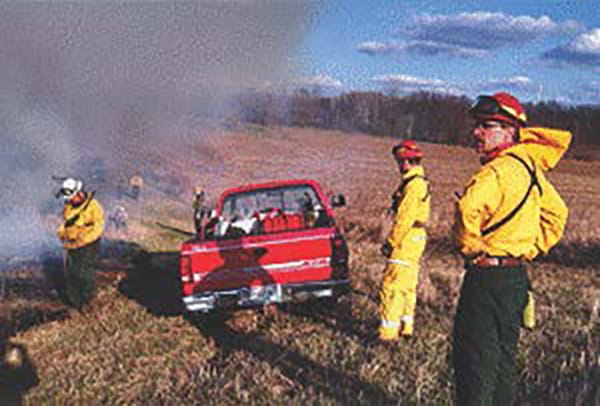
In 2000, The Prairie Enthusiasts began habitat management at Smith-Reiner Drumlin Prairies under an informal management agreement with the landowner, Phyllis Reiner Smith, to restore and care for their prairie remnants. The U.S. Fish and Wildlife Service Private Land Office provided grants during that time to clear trees and brush.
In the late 1980s and in 1992 the Wisconsin Department of Natural Resources wildlife managers burned the western most prairie remnant. Management activities have continued with selective prescribed burnings. In 2013, the agricultural lands of 28 acres were planted into native grasses and forbs by The Prairie Enthusiasts. The long-term management goals for Smith-Reiner Drumlin Prairie are to restore the site, as much as feasible, back to the original prairie ecosystem that was present 170 years ago, to provide critical habitat for rare and declining species, and to provide opportunity for people to experience and enjoy the area’s prairie heritage.

